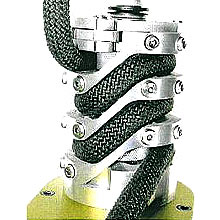 According to Technology Review, it takes about six minutes for a firefighter with a full load of gear to reach the top of a 30-story building by running up the stairs. Of course, one the firefighter gets there, they are exhausted and are less capable of rescuing/carrying someone than if they took the elevator. Of course, they can't take the elevator since the fire could cut the power or the elevator cables leaving the firefighter trapped - or worse freefalling to the bottom.
According to Technology Review, it takes about six minutes for a firefighter with a full load of gear to reach the top of a 30-story building by running up the stairs. Of course, one the firefighter gets there, they are exhausted and are less capable of rescuing/carrying someone than if they took the elevator. Of course, they can't take the elevator since the fire could cut the power or the elevator cables leaving the firefighter trapped - or worse freefalling to the bottom.Well, a group of MIT students have designed a rope-climbing device that can carry 250 pounds at a top speed of 10 feet per second. The U.S. Army has even expressed interest in these devices and they hope to make it available to rescue workers. Of course, my guess is these MIT students developed this fast rope-climbing device so they could more easily carry out their tradition of placing "unusual "devices on the MIT's Great Dome roof. Like, I don't know, say, a police car?

Or climb the roof and quickly turn the Great Dome into R2-D2 before the police arrive? That is, if the police's vehicle isn't already on the roof!

In any event, the MIT students founded a company called Atlas Devices to commercialize the device. According to Technology Review, "Nathan Ball, Atlas's chief technology officer, says that such a device has never been made before because the batteries and motors needed to generate enough power for rapid rope ascents have been bulky and heavy. Atlas's 20-pound machine uses a fast-charging, high-power-density lithium-ion battery made by A123 Systems."
To use the device you wrap the rope around its cylinder and clips it to a harness worn around the waist. The biggest design challenge in making the climber was a mechanical one. "We had to come up with a clever mechanism to grip the rope securely while not damaging it," he says. The device relies on the capstan effect: the more times a rope is wrapped around a cylinder, the stronger the device's grip on the rope. To take advantage of the effect, the MIT students had to make a device that could tightly grip a few turns of a rope while still rapidly advancing it.
The Atlas rope climber can be attached at any point along a rope--a rescue worker could get onto a line from a second-story window, for example. It takes about 10 seconds to wrap the rope three times around the capstan. The climbing device can't shoot a rope up to the top of a building, but Ball says the army already uses grappling hooks to set ropes that soldiers must then climb by hand. A first wave of firefighters or other emergency workers might climb up using the stairs and set a rope for others to follow, or a soldier might be dropped to the top of a building from a helicopter and set a rope.
Check out the video of this in action:









